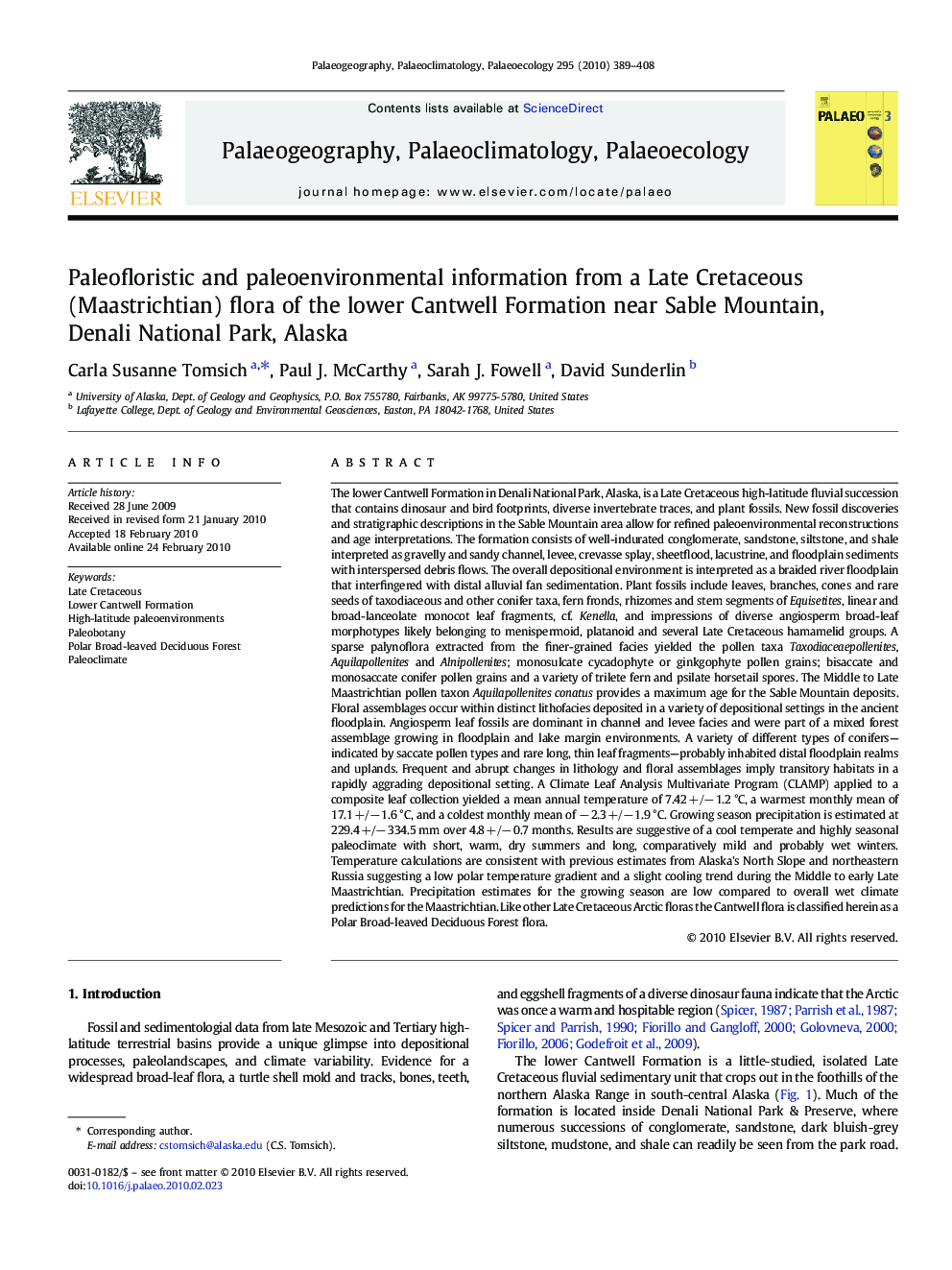| کد مقاله | کد نشریه | سال انتشار | مقاله انگلیسی | نسخه تمام متن |
|---|---|---|---|---|
| 4467580 | 1622271 | 2010 | 20 صفحه PDF | دانلود رایگان |

The lower Cantwell Formation in Denali National Park, Alaska, is a Late Cretaceous high-latitude fluvial succession that contains dinosaur and bird footprints, diverse invertebrate traces, and plant fossils. New fossil discoveries and stratigraphic descriptions in the Sable Mountain area allow for refined paleoenvironmental reconstructions and age interpretations. The formation consists of well-indurated conglomerate, sandstone, siltstone, and shale interpreted as gravelly and sandy channel, levee, crevasse splay, sheetflood, lacustrine, and floodplain sediments with interspersed debris flows. The overall depositional environment is interpreted as a braided river floodplain that interfingered with distal alluvial fan sedimentation. Plant fossils include leaves, branches, cones and rare seeds of taxodiaceous and other conifer taxa, fern fronds, rhizomes and stem segments of Equisetites, linear and broad-lanceolate monocot leaf fragments, cf. Kenella, and impressions of diverse angiosperm broad-leaf morphotypes likely belonging to menispermoid, platanoid and several Late Cretaceous hamamelid groups. A sparse palynoflora extracted from the finer-grained facies yielded the pollen taxa Taxodiaceaepollenites, Aquilapollenites and Alnipollenites; monosulcate cycadophyte or ginkgophyte pollen grains; bisaccate and monosaccate conifer pollen grains and a variety of trilete fern and psilate horsetail spores. The Middle to Late Maastrichtian pollen taxon Aquilapollenites conatus provides a maximum age for the Sable Mountain deposits. Floral assemblages occur within distinct lithofacies deposited in a variety of depositional settings in the ancient floodplain. Angiosperm leaf fossils are dominant in channel and levee facies and were part of a mixed forest assemblage growing in floodplain and lake margin environments. A variety of different types of conifers—indicated by saccate pollen types and rare long, thin leaf fragments—probably inhabited distal floodplain realms and uplands. Frequent and abrupt changes in lithology and floral assemblages imply transitory habitats in a rapidly aggrading depositional setting. A Climate Leaf Analysis Multivariate Program (CLAMP) applied to a composite leaf collection yielded a mean annual temperature of 7.42 +/− 1.2 °C, a warmest monthly mean of 17.1 +/− 1.6 °C, and a coldest monthly mean of − 2.3 +/− 1.9 °C. Growing season precipitation is estimated at 229.4 +/− 334.5 mm over 4.8 +/− 0.7 months. Results are suggestive of a cool temperate and highly seasonal paleoclimate with short, warm, dry summers and long, comparatively mild and probably wet winters. Temperature calculations are consistent with previous estimates from Alaska's North Slope and northeastern Russia suggesting a low polar temperature gradient and a slight cooling trend during the Middle to early Late Maastrichtian. Precipitation estimates for the growing season are low compared to overall wet climate predictions for the Maastrichtian. Like other Late Cretaceous Arctic floras the Cantwell flora is classified herein as a Polar Broad-leaved Deciduous Forest flora.
Journal: Palaeogeography, Palaeoclimatology, Palaeoecology - Volume 295, Issues 3–4, 15 September 2010, Pages 389–408